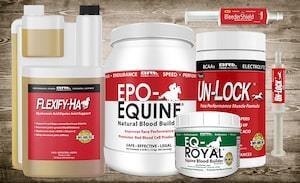
Do you wonder who came up with the first horseshoes?
According to Wikipedia, the earliest known horses evolved 55 million years ago, but historians believe it wasn't until sometime after 100 B.C. that Romans invented "mule shoes."
Just after the 5th century, metal plates were being nailed onto hooves by European riders. Around 1000 A.D., cast bronze shoes appeared; they were also nailed on. Widespread manufacturing of iron horseshoes came in the 13th century, followed by hot shoeing in the 16th century.
The first U.S. patent for a horseshoe-making machine was issued to New York’s Henry Burden in 1835; it could make 60 shoes per hour. It wasn’t until 1861 that J. B. Kendall from Boston received a patent for the first improved horseshoe.
Although horseshoes have been around for centuries, there is controversy regarding their use. If you are on the fence about whether or not to shoe your horses, consider the following:
Horseshoeing Cost
Many horse owners base their shoeing decision on cost. Cost varies from state to state, as well as among farriers.
Farrier rates can increase with education, specialties, experience and travel time required. If your horse needs specialized attention or medication to be properly shod, that can hike fees, too.
Should Your Horse Go Barefoot?
Many owners believe that a horse's environment affects the health of its feet, which can influence the decision regarding whether or not to shoe them. But according to Robert Cook, FRCVS, PhD, professor of surgery emeritus and founder of Tufts University School of Veterinary Medicine, a barefoot horse is a healthier horse. (Cook also developed the bitless bridle).
Cook does not believe that climate or environment determine the need for shoes. Instead, he recommends diligent hoof care and good barn management to reduce the chances that shoes will be needed.
Hoof Health: Growth and Wear
Horse hooves grow and wear down differently, just like human toenails. Certain factors affect growth and wear, such as:- Genetics and breed
- Hoof heath and conformation
- The type of surface where the horse is worked
- Your horse's activity/discipline (pleasure, trail, jumping, barrel racing, retired, etc.)
However, the biggest determining factor is the health of the hoof. Can it withstand the work and the surface? That answer might require a visit from your vet.
Effects of Disease
You may not be very familiar with diseases that your horse hasn’t had. Some equine diseases can be detrimental to hoof health; these include founder/laminitis, white line disease, and navicular disease. These diseases cause numerous hoof issues and often require shoeing from a specialized farrier.
Horseshoe Options
After considering all of the above, if you do decide to shoe there are many options to choose from. Here are a few:
Adhesive Coating: This is the newest shoeing product on the market. Similar to an epoxy, this flexible coating is applied to the bottom of the hoof to protect from things like chipping and bruising, and to strengthen the sole. Applied after trimming, the coating lasts up to six weeks.
Glue-On Shoes: These shoes are used when the hoof wall is too thin for nails. They’re lightweight and can be custom-fitted, but can also be expensive. If your horse’s environment is muddy, they might not be a good option.
Fiberglass Casts: Most often used as a long-term alternative when other options have failed, fiberglass casts can be expensive. It can also be difficult to find a farrier who specializes in making and applying them.
Hoof Boots: These are temporary boots, used for therapeutic reasons or if you don’t want your horse going barefoot for a ride in rocky terrain. They come in different sizes and need to fit well. Instead of Velcro, they utilize a strong hook and loop clasp. Hoof boots are made of a rubber-type material and are affordable and durable.
Hoof Wraps: There are a variety of hoof wraps on the market, and they work well to protect from injuries, bruises, abscesses, etc. They’re cost-effective and easy to use.
Still undecided? Consider your horse’s health and circumstances, and consult your vet and farrier.
Top trainers, owners and competitors rely on BRL Equine products to help their horses perform at their very best. You can get the same great results! Our all-natural equine nutritional supplements really work... guaranteed or your money back!





Also in Horse Tips and More
Top 10 Ways to Show Your Horse You’re Thankful For Him
November 01, 2021
View full article →
5 Ways to Prepare Your Barn For Summer
May 03, 2021
View full article →
Your New Spring Horse Health Checklist
March 12, 2021
View full article →